Children’s and adolescent literature has the power to open windows and doors into new worlds and lived experiences. Historically, the experiences of Latina/o children, families, and communities have been lacking from the corpus of literature published in the U.S. Moreover, some literature that is categorized as Latina/o-centric offers only cursory, stereotypical, or, at worst, deficit views of Latina/o families and experiences, as reported in Journal of Children’s Literature in 2013.
Instead, Latina/o children and those who read about Latina/o children and families should be exposed to characters and narratives that embody the complexity, excellence, and unique funds of knowledge that Latina/o communities offer, as K Hasse suggested in The Delta Kappa Gamma Bulletin. The literature that is reviewed in this column meets and surpasses these qualifications, providing critical encounters with literature that disrupt single-story or majoritarian narratives of Latina/o children, families, and communities. The selections can be shared with students at all grade levels.
Drum Dream Girl: How One Girl’s Courage Changed Music. Margarita Engle. Ill. Rafael López. 2015. Houghton Mifflin Harcourt.
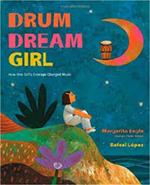 Engle’s book depicts a young girl’s persistence to play the drums in a world where “only boys play drums.” Lopez’s words border poetry as we read how Drum Dream Girl’s world is filled with beats and music. Lopez writes, “When she walked under the wind-wavy palm trees in a flower-bright park she heard the whir of parrot wings the clack of woodpecker beaks the dancing tap of her own footsteps and the comforting pat of her own heartbeat,” showing how Drum Dream Girl draws inspiration from the world around her. The cadence of Engle’s prose mirrors the tap, tap, tapping of a drum as we are guided through Drum Dream Girl’s quest to defy gender norms and play the drums. The words are supported by the illustrations which present a whimsical, botanical world that blurs the lines between reality and fantasy.
Engle’s book depicts a young girl’s persistence to play the drums in a world where “only boys play drums.” Lopez’s words border poetry as we read how Drum Dream Girl’s world is filled with beats and music. Lopez writes, “When she walked under the wind-wavy palm trees in a flower-bright park she heard the whir of parrot wings the clack of woodpecker beaks the dancing tap of her own footsteps and the comforting pat of her own heartbeat,” showing how Drum Dream Girl draws inspiration from the world around her. The cadence of Engle’s prose mirrors the tap, tap, tapping of a drum as we are guided through Drum Dream Girl’s quest to defy gender norms and play the drums. The words are supported by the illustrations which present a whimsical, botanical world that blurs the lines between reality and fantasy.
Drum Dream Girl teaches the reader about the importance of pursuing what we love, about listening to our dreams, and the power of parents and important adults in shaping the interests and trajectories of young girls. The importance of women in the lives of women is also evident as Drum Dream Girl receives support from her sister’s “all-girl dance band,” showing how her comadres cultivated her dream. Ultimately, Drum Dream Girl’s father does provide lessons, in which she eagerly immerses herself. With practice and the guidance of her teacher, she achieves her goal. Drum Dream Girl invites readers to ask questions about the positioning of girls and boys, the impact of adults on the dreams of young children, and how even the strongest held traditions can be bent, changed, or transformed.
—LR
Finding the Music/En Pos de la Música. Jennifer Torres. Ill. Renato Alarcão. 2015. Children’s Book Press/Lee & Low Books, Inc.
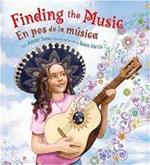 This bilingual picture book acknowledges family heritage while celebrating the power music has to bring joy, bridge generations, and build community. Reyna’s abuelito was a gifted mariachi musician, and his vihuela, a small, high-pitched guitar, is proudly displayed in her family’s restaurant. Reyna accidently breaks the vihuela and decides to fix it before her mother learns about the incident. Reyna reaches out to several individuals in the community for assistance. During her search, she discovers precious mementos related to her abuelito’s life as a mariachi musician. She receives a photo from Mr. Antonio of the hardware store, but she also learns a special story. “None of us had much money then, so instead of a gift, your abuelito and his mariachi played for us.” She meets the school music teacher who shares that her abuelito taught her on the vihuela, but the special memento that she receives (her abuelito’s sombrero) makes her beam with pride. Finally, she stops at the music shop and receives an old record with a recording of her abuelito’s mariachi band performance. The rich details coupled with the warm hues create a balance to this tenderhearted story. There is also an author’s note with additional information about mariachi music.
This bilingual picture book acknowledges family heritage while celebrating the power music has to bring joy, bridge generations, and build community. Reyna’s abuelito was a gifted mariachi musician, and his vihuela, a small, high-pitched guitar, is proudly displayed in her family’s restaurant. Reyna accidently breaks the vihuela and decides to fix it before her mother learns about the incident. Reyna reaches out to several individuals in the community for assistance. During her search, she discovers precious mementos related to her abuelito’s life as a mariachi musician. She receives a photo from Mr. Antonio of the hardware store, but she also learns a special story. “None of us had much money then, so instead of a gift, your abuelito and his mariachi played for us.” She meets the school music teacher who shares that her abuelito taught her on the vihuela, but the special memento that she receives (her abuelito’s sombrero) makes her beam with pride. Finally, she stops at the music shop and receives an old record with a recording of her abuelito’s mariachi band performance. The rich details coupled with the warm hues create a balance to this tenderhearted story. There is also an author’s note with additional information about mariachi music.
—MN
Growing up Pedro. Matt Tavares. 2015. Candlewick Press.
 Red Sox fan Matt Tavares’ latest picture book biography provides readers with information about Pedro Martinez and his brother Ramon, both of whom grew up in the Dominican Republic. Organized by important milestones with concise text, readers learn about Pedro’s early life and his strong relationship with his brother. Tavares includes information about the positive influence Pedro’s older brother, Ramon had on his life. Information about Ramon’s selection as a Major League Baseball player fuels Pedro’s commitment to follow in his brother’s footsteps.
Red Sox fan Matt Tavares’ latest picture book biography provides readers with information about Pedro Martinez and his brother Ramon, both of whom grew up in the Dominican Republic. Organized by important milestones with concise text, readers learn about Pedro’s early life and his strong relationship with his brother. Tavares includes information about the positive influence Pedro’s older brother, Ramon had on his life. Information about Ramon’s selection as a Major League Baseball player fuels Pedro’s commitment to follow in his brother’s footsteps.
The author’s note includes important facts about how Martinez gave back to his hometown in the Dominican Republic from building schools, paving roads, and baseball fields. The beautiful illustrations complement the narrative and the selection would partner well with other biographies about baseball players, including those by Matt Tavares: Henry Aaron’s Dream and There Goes Ted Williams.
—MN
Little Chanclas. Josó Lozano. 2015. Cinco Puntos Press.
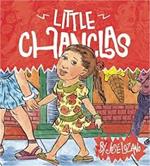 In Little Chanclas, Lozano presents a small but mighty little girl who wears noisy chanclas. In a world where girls are often encouraged to be quiet and sacrifice comfort for style, Lily defies the norm by “slippety-slappetying” through life with her beat-up chanclas. Lily even wears her chanclas to parties, much to the chagrin of her mother and other party-goers. Both tragedy and hilarity ensue at the party when Lily’s chanclas break while she is dancing and a dog gobbles up the pieces of her beloved shoes. All is resolved later in the story when Lily’s granny arrives with new chanclas in every color.
In Little Chanclas, Lozano presents a small but mighty little girl who wears noisy chanclas. In a world where girls are often encouraged to be quiet and sacrifice comfort for style, Lily defies the norm by “slippety-slappetying” through life with her beat-up chanclas. Lily even wears her chanclas to parties, much to the chagrin of her mother and other party-goers. Both tragedy and hilarity ensue at the party when Lily’s chanclas break while she is dancing and a dog gobbles up the pieces of her beloved shoes. All is resolved later in the story when Lily’s granny arrives with new chanclas in every color.
Young children will enjoy the onomatopoeia used through the book to describe the sound of Lily’s chanclas. Those who are familiar with the linguistic nuances of the border regions and Spanish-speaking enclaves in the U.S. will identify with the authentic use of Spanglish in both the English and Spanish text to contextualize and describe Lily’s environment; for example, shopping at the Shoeteria and eating dinner at the Sushiteria.
—LR
Lola Levine is Not Mean. Monica Brown. 2015. Little, Brown Books for Young Readers.
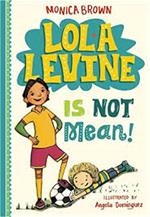 The salutations “Dear Diario” and “Shalom” at the onset of this book set the stage for the intersectional identities that are presented in Monica Brown’s Lola Levine is Not Mean. Through Lola’s diary entries and narrative, Brown addresses gender, language, and cultural themes to explore challenges and potentials when we resist or step outside of society’s norms. The issue of gender identity plays a role in the main conflict of the story as Lola Levine experiences the different expectations of girls/women in sports. When Lola displays confidence and competitiveness in a soccer game at school, she accidentally injures a male classmate. This treatment sets in motion a series of events that can only be described as bullying. Lola’s classmates call her “Mean Lola Levine” and isolate her from social interactions at school. The school principal, who happens to be a woman, bans Lola from soccer and effectively shames Lola for her “behavior.” As the events of the story unfold, the complexities of how norms are enforced and resisted against by different female characters are shown. The principal and Lola’s classmates show a clear preference for adhering to gender norms while Ms. Garcia, Lola’s favorite teacher, and Lola’s mother offer support and solutions. While bullying is often addressed in simplified or superficial ways in children’s literature, Brown moves beyond this common trope by clearly showing bullying is often underpinned and supported by issues of prejudice. Brown shows that Lola still resists these prescribed norms and, rather than changing who she is, resists against the attacks on her character.
The salutations “Dear Diario” and “Shalom” at the onset of this book set the stage for the intersectional identities that are presented in Monica Brown’s Lola Levine is Not Mean. Through Lola’s diary entries and narrative, Brown addresses gender, language, and cultural themes to explore challenges and potentials when we resist or step outside of society’s norms. The issue of gender identity plays a role in the main conflict of the story as Lola Levine experiences the different expectations of girls/women in sports. When Lola displays confidence and competitiveness in a soccer game at school, she accidentally injures a male classmate. This treatment sets in motion a series of events that can only be described as bullying. Lola’s classmates call her “Mean Lola Levine” and isolate her from social interactions at school. The school principal, who happens to be a woman, bans Lola from soccer and effectively shames Lola for her “behavior.” As the events of the story unfold, the complexities of how norms are enforced and resisted against by different female characters are shown. The principal and Lola’s classmates show a clear preference for adhering to gender norms while Ms. Garcia, Lola’s favorite teacher, and Lola’s mother offer support and solutions. While bullying is often addressed in simplified or superficial ways in children’s literature, Brown moves beyond this common trope by clearly showing bullying is often underpinned and supported by issues of prejudice. Brown shows that Lola still resists these prescribed norms and, rather than changing who she is, resists against the attacks on her character.
Overall, this book invites the reader to ask, “Is Lola mean? Why or why not?” and sets the stage for educators to select strategic stopping points to engage in dialogue about the roles women and girls can embody. Readers can explore the contradictory expectations placed on girls and women, questions about friendships between boys and girls, the power of art and writing, and the way we support or deny multiple ways of knowing and being at school and at home.
—LR
Mango, Abuela, and Me. Meg Medina. Ill. Angela Dominguez. 2015. Candlewick Press.
 Medina’s Mango, Abuela, and Me is a contemporary story depicting the realities of immigration and the inevitable impact on la familia. Namely, the story illuminates the experience of language loss across generations, a reality for many second- and third-generation immigrants. In this story, a young girl named Mia is anxious about the arrival of her abuela, who comes to live with her and her family. Since Mia’s primary language is English and Abuela speaks only Spanish, Mia and Abuela initially find it difficult to connect and express love through words.
Medina’s Mango, Abuela, and Me is a contemporary story depicting the realities of immigration and the inevitable impact on la familia. Namely, the story illuminates the experience of language loss across generations, a reality for many second- and third-generation immigrants. In this story, a young girl named Mia is anxious about the arrival of her abuela, who comes to live with her and her family. Since Mia’s primary language is English and Abuela speaks only Spanish, Mia and Abuela initially find it difficult to connect and express love through words.
Over time, Mia fills her home with English labels, Mia and Abuela share English and Spanish words while cooking together, and Mia and her mother purchase a parrot, Mango, who reminds Abuela of her house by the sea. The parrot becomes a key player in the bilingual exchanges that occur between Mia and Abuela. Medina pays careful attention to what it means to live in a new language. She writes that Abuela can’t “unlock the English words” which expertly and succinctly portrays the time it takes to adopt a new linguistic repertoire. In the end, Mia says, “Our mouths are full of things to say.”
—LR
Maya’s Blanket. Monica Brown. Ill. David Diaz. 2015. Lee & Low Books, Inc.
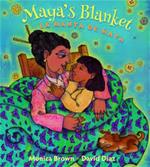 In this beautifully illustrated, bilingual picture book, inspired by by the Yiddish folk song “Hob Ikh Mir a Mantl” (“I had a little coat”), Monica Brown provides readers with a story that celebrates love, family, creativity, and resourcefulness. Young Maya loves her handmade magical butterfly printed blanket crafted by her abuelita. When the blanket becomes old and frayed, she decides to create something new. “With her own two hands and Abuelita’s help,” Maya recreates the blanket into a dress, a skirt, a shawl, and a scarf, until it was so small that she was only able to make a bookmark. Maya’s ability to invent and create culminates into her writing a story filled with memories of the blanket’s metamorphosis. The butterfly print symbolizes renewal and, each time the blanket is refashioned into a new creation, it becomes a testimony of renewal and preservation. The cumulative structure coupled with the bright illustrations contribute to its heartwarming message. It will certainly inspire readers of all ages to reuse and recycle usable objects and to appreciate special treasures and family heirlooms.
In this beautifully illustrated, bilingual picture book, inspired by by the Yiddish folk song “Hob Ikh Mir a Mantl” (“I had a little coat”), Monica Brown provides readers with a story that celebrates love, family, creativity, and resourcefulness. Young Maya loves her handmade magical butterfly printed blanket crafted by her abuelita. When the blanket becomes old and frayed, she decides to create something new. “With her own two hands and Abuelita’s help,” Maya recreates the blanket into a dress, a skirt, a shawl, and a scarf, until it was so small that she was only able to make a bookmark. Maya’s ability to invent and create culminates into her writing a story filled with memories of the blanket’s metamorphosis. The butterfly print symbolizes renewal and, each time the blanket is refashioned into a new creation, it becomes a testimony of renewal and preservation. The cumulative structure coupled with the bright illustrations contribute to its heartwarming message. It will certainly inspire readers of all ages to reuse and recycle usable objects and to appreciate special treasures and family heirlooms.
—MN
Miracle on 133rd Street. Sonia Manzano. Ill. Marjorie Priceman. 2015. Atheneum Books for Young Readers.
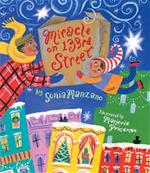 Sonia Manzano’s newest picture book celebrates the power of community and how one family’s quiet holiday dinner plans turned into a wonderful celebration. On Christmas Eve, Mami, Papi, and José were preparing their special dinner, but when the roast doesn’t fit into their oven, it sets into motion a sequence of events that brings friends and neighbors together. Manzano’s excellent writing offers strong characterization coupled with the perfect blend of emotion and dialogue. This wonderful holiday story is brought to life with colorful and magical illustrations perfect for December story times and thematic lessons about family/community.
Sonia Manzano’s newest picture book celebrates the power of community and how one family’s quiet holiday dinner plans turned into a wonderful celebration. On Christmas Eve, Mami, Papi, and José were preparing their special dinner, but when the roast doesn’t fit into their oven, it sets into motion a sequence of events that brings friends and neighbors together. Manzano’s excellent writing offers strong characterization coupled with the perfect blend of emotion and dialogue. This wonderful holiday story is brought to life with colorful and magical illustrations perfect for December story times and thematic lessons about family/community.
—MN
My Tata’s Remedies/Los Remedies de mi Tata. Roni Capin Rivera-Ashford. Ill. Antonio L. Castro. 2015. Cinco Puntos Press.
 My Tata’s Remedies/Los Remedies de mi Tata presents a young boy, Aaron, who guides the reader through his father’s practice of holistic medicine. Sometimes referred to as curanderismo, folk, or natural healing, the book sheds light on the rich knowledge of how our natural environment offers solutions to our ailments.
My Tata’s Remedies/Los Remedies de mi Tata presents a young boy, Aaron, who guides the reader through his father’s practice of holistic medicine. Sometimes referred to as curanderismo, folk, or natural healing, the book sheds light on the rich knowledge of how our natural environment offers solutions to our ailments.
As each neighbor, friend, or family member arrives at Aaron’s home, Tata knows just what to do. He enlists Aaron’s help in seeking the right remedy for each ailment. Through this process, we see how children are apprenticed to the knowledge that is passed down through generations of healers. The strength of la familia y la communidad is also a primary theme in this text, showing the ways in which members of la communidad rely on one another to share their unique and vital funds of knowledge.
Both English and Spanish appear on the page, with English taking first billing. Select words and phrases are included in the English text. The names of plants and herbs are listed in both Spanish and English, allowing readers to delve into both language and content through this resource. The illustrations mirror this approach with realistic sketches that expertly capture the expressions of characters and accurate renderings of the plants used for Tata’s remedies.
—LR
Sofi and the Magical, Musical Mural/Sofi y el magico mural musical. Raquel Ortiz. Ill. Maria Dominguez. Trans. Gabriela Baeza Ventura. 2015. Piňata Books/Arte Público Press.
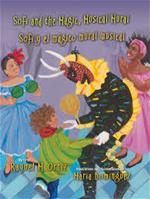 This bilingual picture book celebrates public art murals and culture, specifically the one located in the South Bronx entitled, “El Pueblo Cantor” (The Pueblo Sings). While walking back to her apartment building, Sofia becomes transfixed by the vibrant colors in the public mural that celebrates Puerto Rican culture. As she stares at the images, she is slowly transported, through her imagination, into the lively scene. She dances with new friends, sings traditional songs, and is initially fearful of the masked trickster, the vejigante. She is encouraged to continue dancing and dancing until her original fear of the vejigante in the mural slowly disappears. Her imagination transports her into the air over the town, the rainforest, and the beach. Finally, her mother finds Sofia deeply entranced in front of the mural. Sofia realizes that she had been daydreaming. At home, she was still so deeply affected by the characters in the mural that she continued to dance and sing. From her bedroom window, she could still see the mural and even imagined that the vejigante winked at her. The story captures the power that art has on our senses and would be appropriate for art educators. Art educator and muralist Maria Dominguez adds colorful and spiraling illustrations to enhance the story.
This bilingual picture book celebrates public art murals and culture, specifically the one located in the South Bronx entitled, “El Pueblo Cantor” (The Pueblo Sings). While walking back to her apartment building, Sofia becomes transfixed by the vibrant colors in the public mural that celebrates Puerto Rican culture. As she stares at the images, she is slowly transported, through her imagination, into the lively scene. She dances with new friends, sings traditional songs, and is initially fearful of the masked trickster, the vejigante. She is encouraged to continue dancing and dancing until her original fear of the vejigante in the mural slowly disappears. Her imagination transports her into the air over the town, the rainforest, and the beach. Finally, her mother finds Sofia deeply entranced in front of the mural. Sofia realizes that she had been daydreaming. At home, she was still so deeply affected by the characters in the mural that she continued to dance and sing. From her bedroom window, she could still see the mural and even imagined that the vejigante winked at her. The story captures the power that art has on our senses and would be appropriate for art educators. Art educator and muralist Maria Dominguez adds colorful and spiraling illustrations to enhance the story.
—MN
Mary Napoli is an associate professor of reading at Penn State Harrisburg and focuses her teaching and research on children’s and adolescent literature. She teaches both undergraduate and graduate literacy courses focused on children’s literature. Her current research pertains to guiding preservice teachers to become more critical readers of texts. Laura Roy is an associate professor of education at Penn State Harrisburg. Laura’s research examines the classroom and community experiences of new and existing refugee and immigrant populations in the U.S., focusing particularly on the intersections of race, culture, language, and other markers of identity. She is particularly interested in the discursive practices in the classroom that help and/or hinder students’ success in language learning contexts. Both her teaching and research are grounded in social justice frameworks, advocating for equitable learning opportunities for all students.
These reviews are submitted by members of the International Literacy Association's Children's Literature and Reading Special Interest Group (CL/R SIG)and are published weekly on Literacy Daily.